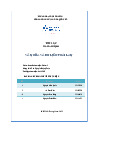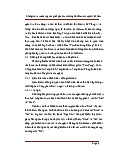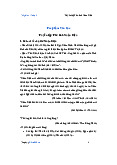



















Preview text:
Cambridge English Qualifi cations A2 Flyers Practice Tests Plus Teacher’s Guide Second Edition Teaching not just testing Kathryn A with Elain Pearson Education Limited KAO Two KAO Park Harlow Essex CM17 9NA England
and Associated Companies throughout the world.
pearsonELT.com/practicetestsplus
© Pearson Education Limited 2018
First edition text by Kathryn Alevizos. Second edition prepared by Elaine Boyd.
All rights reserved; no part of this publication may be reproduced, stored in a
retrieval system, or transmitted in any form or by any means, electronic, mechanical,
photocopying, recording, or otherwise without the prior written permission of the Publishers. Typeset by Hart McLeod Ltd
Cover Image reproduced here by permission of Cambridge ESOL. This image is
drawn from the CYLE Tests Sample Papers, published by Cambridge ESOL, 2006.
The 1st edition author has asserted her moral right in accordance with Section 77
of the Copyright, Designs and Patents Act 1988. First published 2012 Second edition 2018
British Library Cataloguing in Publication Data
A catalogue record for this book is available from the British Library ISBN 978 1 292 24022 0 Printed in UK, by CPI Note from the publisher
Pearson has robust editorial processes, including answer and fact checks, to ensure
the accuracy of the content in this publication, and every effort is made to ensure this
publication is free of errors. We are, however, only human, and occasionally errors do
occur. Pearson is not liable for any misunderstandings that arise as a result of errors
in this publication, but it is our priority to ensure that the content is accurate. If you
spot an error, please do contact us at resourcescorrections@pearson.com so we can make sure it is corrected. Contents
Introduction .................................................................................................................4 Teacher’s Notes
Test 1 ......................................................................................................................8
Test 2 ....................................................................................................................36
Test 3 ....................................................................................................................60
Test 4 ....................................................................................................................84
Test 5 ..................................................................................................................108
Examiner’s copies of Speaking Tests ........................................................................132
Photocopiable worksheets .......................................................................................142
A2 Flyers grammar and structures list ....................................................................156
A2 Flyers alphabetic vocabulary list .......................................................................157 Introduction
TheYoung LearnersPractice Tests Plus series is aimed
■ A2 Flyers Listening Exam
at students aged 7–12 years who are preparing for
the Cambridge English Qualifications for young Overview
learners. It consists ofthreelevels: Pre A1 Starters, Parts What is the What does the
A1 Movers and A2 Flyers. (25 minutes) skills focus? child do?
The exams are suitable for students of all 1 (5 questions) Listening for Draws lines
nationalities whose first language is not English, names and between names
whatever their cultural background. They cover descriptions and people in
all four language skills – reading, writing, listening apicture
and speaking and include a range of tasks which
assess candidates’ ability to use and communicate 2 (5 questions) Listening for Writes numbers
effectively in English. All candidates who complete spellings, or words in gaps
their exam receive an award, which focuses not on names
what they cannot do but on what they can do. The and other
award certificate has a shield score boundary which information
outlines individual attainment. The Young Learners 3 (5 questions) Listening Matches pictures
exams are aligned with the Common European for detailed with illustrated
Framework of References for Language, at levels A1 information items by writing
and A2. They also provide an appropriate first step a letter in a box
towards the main Cambridge English Qualifications 4 (5 questions) Listening Chooses between
for Schools (Key for Schools and Preliminary for for specific three options Schools). information by putting a ■ Components tick under the correct box
The components of Young Learners Practice Tests Plus are: 5 (5 questions) Listening Follows • for specific instructions to
The Student’sBook, which contains five practice
tests. Each test is divided into three sections: information colour items in a
Listening, Reading & Writing and Speaking. such as picture and write
Teachers may wish to use some of the tests as colours and
classroom practise activities before doing the words others under exam conditions. Guidance
• The Teacher’s Guide, which contains an Part 1
overview and teaching tips for each part of the
exam; reduced pages of theStudent’s Bookwith
• Students need to know the names they are likely
embedded answers in place; Teaching guidelines
to encounter in the exam. These include the
for each test;a Speaking frame for each test giving
names new to A2 Flyers (see page 160) but also
procedures and language to use in each speaking
names from Pre A1 Starters and A1 Movers.
test; 14 photocopiable worksheets with Teacher’s
• Encourage students to spend time looking at
Notes; Cambridge English Qualifications for young
the picture before they listen to the dialogue.
learners grammar, structures and vocabulary
In particular, encourage them to identify
lists. Test 1 of each level has suggested warm-up
differences between people who look similar or
activities and worksheets. Teachers can choose who are doing similar things.
when to use these: with Test1 only or throughout
• Make sure students have read the names around all five tests.
the picture before they listen to the dialogue so
• The Digital Resources, which include the
they know what names to expect. Remind them
recording for the Listening tests, the audioscripts,
there is one name they do not need.
avideo ofSpeaking test 1 andvideotranscripts.
• Remind students of the importance of drawing
The video of the Speaking test in the digital
clear lines between the names and the people in
resources, together with the Speaking frame the picture.
in the Teacher’s Guide, are designed to give
teachers a detailed example of how to go about
providing students with realistic practice for the Speakingexam. 4 Introduction Introduction Part 2 Teaching Tips
• Encourage students to predict what kind of
• Make sure students know what is expected of
information is missing before they listen to the
them in each part. Read the instructions and
dialogue. For example, whether it is a day of the
listen to the example. Pause the recording to
week or a time that they need to listen out for. check students understand.
• Make sure students are aware of the fact that
• Always play the recording twice. If necessary
there is likely to be a name spelt out in this
with the first two or three tests, play the
part and sometimes also a telephone number. recording a third time.
As a result, students need to be confident in
• When checking answers, make use of the
recognising digits and letters of the alphabet.
audioscript. Give students a copy of it and then
Some misspellings will be allowed for words
play the recording again. Students listen and
thatare not spelt out on the recording. read to check their answers. Part 3
• Remind students that there are eight pictures
■ A2 Flyers Reading & Writing Exam
and so there are two that are not needed. Overview
• Encourage students to look at the pictures before
listening to the dialogue and think about how the Parts What is the What does
pictures would be described in English so they (40 minutes) skills focus? the child do?
can anticipate which words they are likely to 1 (10 questions) Reading and Matches words hear. understanding to the correct Part 4 definitions and definitions
• Encourage students to spend time looking at copying words
the three pictures for each question before they 2 (5 questions) Reading and Chooses the
listen to the dialogues. In particular, get students understanding correct answer
to think about the differences between the a short dialogue for each gap pictures. and writing and writes the
• Make sure students listen to the whole of each letters appropriate
dialogue before choosing A, B or C. The answer letter A–H
may come at any point in each of the dialogues 3 (6 questions) Reading for Chooses the
and students should be reminded not simply to detail and gist correct word
tick the first option they hear. and copying for each gap
• Remind students to make their ticks very clear. words in the text and selects the
• Remind students to use the second time they best title for
hear the recording to check their answers. the story Part 5 4 (10 questions) Reading and Selects the
• Encourage students to spend time looking at understanding correct word
the picture before they listen to the dialogue. In a factual text for each gap
particular, encourage them to identify people or and copying inthe text
objects that are similar as these may be targeted. words to fill
For example, if there are two boys in the picture, thegaps
what makes them different from each other?
Does one wear glasses or is one boy taller than 5 (7 questions) Reading and Completes
the other? By doing this, students can predict understanding sentences
what they may hear in the recording. a story and about the completing story using 1,
• Remind students of the importance of writing sentences 2, 3 or 4 words clearly. about it Introduction 5 Introduction 6 (5 questions) Reading and Provides an Part 5 understanding appropriate
• Remind students to copy words from the text a short text word for each correctly. such as a gap in the text
• Encourage students to underline the parts of postcard or an
the text that relate to the sentence they need to extract from complete. adiary Part 6 7 (writing a Looking at and Writes a short
• Encourage students to think about what kind of story) understanding story based on
word is missing and to look at the text before and three three pictures
after the gap. The focus of the task is lexical and pictures and grammatical. constructing a
• Remind students also to think about the tense if narrative the missing word is a verb. Guidance Part 7 Part 1
• Encourage students to look at all three pictures
• Encourage students to read all the definitions
first and observe what is happening in each.
before choosing the answers. Remind them that
• Encourage students to think about how to
there are five words they will not need.
express the events and put them in the correct
• Remind students that they will lose marks if they order.
do not copy the words correctly. For example, if Teaching Tips
they spell the word incorrectly, leave out articles, or add unnecessary articles.
• Make sure students know what is expected of
them in each part. Read the instructions and the Part 2
example and check students understand.
• Encourage students to read all the possible
• Marks are often lost because letters and / or
responses before making their choice. At first it
words are not written clearly. Students should
may appear that more than one response fits a
check that their handwriting is clear and they
gap in the dialogue and so students need to read
should be given plenty of handwriting practice.
the different options carefully.
• Tell students to write only as much as is needed
• Remind students that there are two responses
in each gap. Marks can be lost when students they do not need.
attempt to write more than is necessary, as it
• Encourage students to check their answers by
often leads to more mistakes being made.
reading the whole dialogue to see if it makes
• Teach your young students to manage their time sense.
well. Set time limits in class so that they can Part 3
experience the limited time of the exam. This will
• Encourage students to read the whole text before
help students concentrate and be less distracted
choosing the answers so that they get a general by other things.
idea of what the story is about.
• Make sure students are familiar with the
• Remind students to look at the words that come
structures and vocabulary in the Pre A1 Starters,
before and after the gap to help them decide
A1 Movers and A2 Flyers syllabus (For the A2 which word is correct.
Flyers syllabus see pages 156–160).
• Encourage students to think about what part of
speech the missing word is, i.e. a noun, a verb, an adverb or an adjective. Part 4
• Encourage students to read through the text first.
• Encourage students to think about what kind of
word is missing and to look at the words before
and after the gap to get clues as to which word
fits. The focus of this task is grammatical. 6 Introduction Introduction
■ A2 Flyers Speaking Exam Part 3 Overview
• Remind students that the examiner will ask
them to look at all five pictures before they start Parts What is the What does the
the task and that it’s a good idea for students (7-9 minutes) skills focus? child do?
to try and get a general idea of the story before
they start. However it is also worth reassuring 1 Understanding Identifies the
students that if they cannot see how the pictures sentences six differences
link together, they can simply describe what they about pictures between his / can see in each picture. and making her picture and statements the examiner’s
• Encourage students to think about the grammar describing the picture
they will need to use to tell the story. For differences
example, to use present perfect for things that between pictures
have already happened in the story (they have
forgotten their camera) or present continuous for 2 Understanding Asks and
things that are happening in the picture (they are and responding answers having a picnic). to questions questions and asking about two Part 4 questions to gain people,
• Encourage students to listen carefully to the information situations or
examiner’s questions but remind them that they objects
can ask the examiner if they don’t understand. 3 Understanding Describes
• Give students practice answering questions the introduction pictures in
about themselves, their families and friends, of a story and order to tell
their homes, their school, their free-time then telling the astory
activities and their likes and dislikes. rest of the story
• Only simple answers of between one to four 4 Understanding Answers
words are expected, though encourage them to and answering personal
use full sentences if they can. personal questions
• Questions will normally be in the present tense questions
but candidates should be prepared to talk
about what they did in the recent past (e.g. last Guidance weekend). Part 1 Teaching Tips
• Remind students to listen carefully to what
the examiner says and to try and use the same
• Make sure students know what is expected of
language in giving their response. For example:
them in each part. They should know that they
are required to follow instructions and to talk in
Examiner – In my picture, there is a red book under
a very simple way about different pictures and to the table.
answer simple questions about themselves.
Candidate – In my picture, there is a blue book under
• Use English in class as much as possible. the table.
Students should be familiar with everyday
• Encourage students to respond in complete
classroom instructions. Teach them how to say sentences.
Sorry or I don’t understand when appropriate. Part 2
• Get students to do each speaking task in pairs
• Remind students that the examiner will ask the
before asking them to do it in front of the class.
questions first and to listen to these carefully
• Give students plenty of practice doing each type
as they will need to ask the examiner the same of task.
questions. Also give them plenty of practice in
• Make sure students are familiar with the
forming questions from prompts.
structures and vocabulary in the Pre A1 Starters,
• Students need only give short answers.
A1 Movers and A2 Flyers syllabus (For the A2
Flyers syllabus see pages 156–160). Introduction 7 Test 1 Listening Test 1 Part 1 5 questions
Listen and draw lines. There is one example. Listening Part 1
In this part, students listen and Richard Helen Harry Sarah draw lines to match names to people in a picture. ■ Warm-up Activity 1
Aim: To practise the names that
appear in the A2 Flyers exam. Materials: Sheets of paper or notebooks Procedure 1 Write the names that may
appear in the A2 Flyers exam on the board (see vocabulary list, TG page 157–160). 2 Drill the names and ask students to repeat. 3 Read out eight of the names in a random order and ask students to write them down. Check answers by getting individual students to say a name each in order. 4 Put students in pairs. They take turns choosing four names and spelling these to their partner. Paul Katy Robert 5 Remember also to revise the 4 Test 1, Listening Part 1
names from Pre A1 Starters and A1 Movers. Activity 2
Aim: To practise vocabulary for 4 Check answers. Extension descriptions.
5 Ask students to draw pictures Get students to bring in
Materials: TG p142 Worksheet 1 of two different people and magazine pictures of people write sentences about them Procedure doing different things. In a using the vocabulary from the small group, you could stick 1 Put students into pairs. word cards. the pictures up around the
2 Give each pair the word cards classroom and get students to from the worksheet. Answer Key
go and stand next to the person
3 Write the following headings
Clothes: belt, shorts, pocket, you describe. Students could
on the board: 1 clothes, scarf, sweater, coat, glasses
then take it in turns to describe
2physical appearance, 3actions. Physical appearance: hair,
a picture to other students. In Students group the cards into blonde, beard, curly,
a larger group, where this may
the categories, e.g. coat and moustache, straight,
not be practical, students could
glasses will go into group one, thin,fat, striped
work in pairs with a selection
curly and straight into group
Actions: sitting, lying, smiling,
of pictures on their desk. Each two, and smiling and running laughing, standing, playing,
student describes a person for into group three. running, throwing
their partner to pick out from the selection of pictures. 8 Test 1, Listening Part 1 Listening ■ Do the test
Fch Oh, that’s Robert. He’s very
Materials: SB page 4, Audio 1.1 good at drawing animals. 1 Ask students to turn to SB M Look at the other table. page 4. Look at the picture They’re painting pictures together and get students to of faces. read the names written at the Fch Yes, they’re painting top and bottom of the picture. people in the class.
2 Play the recording and pause it M Who’s the girl with after the example. Go through long brown hair? Look, the example with the class, she’s sitting next to the making sure they understand bookcase. what they need to do.
Fch That’s Katy. She won the
3 Play the rest of the recording. school art competition last Students draw a line from year – she loves art. the names to the appropriate Can you see my friend people in the picture. Helen? She’s talking to 4 Let students listen to the myteacher. recording again. Check M No. Where is she? answers.
Fch She’s there, near the door. Audioscript 1.1 M Oh. Is she wearing glasses? Fch No, she’s the one with R = Rubric curly hair. Fch = Female child M Where’s your friend, Sarah, M = Male adult then? R Listen and look. There is Fch Oh, she’s getting some one example. more paper from the teacher’s desk. Fch Dad! Come and look at my photos. M Is that her with the pink skirt? M OK. Oh, is this a photo of your new Art club? Fch No, she’s standing next to that girl. She’s wearing
Fch Yes, look – there’s Richard! green trousers. They’re M Where? going to do some drawing,
Fch There! He’s standing next I think. to the window – he’s the M Who’s the boy over there? boy with the red T-shirt. Look, he’s looking for M Oh, yes. He’s holding a something under the table. bottle of blue paint. Fch Oh, that’s Harry. R Can you see the line? This M What’s he looking for? is an example. Fch I think he dropped his Now you listen and draw pencil. lines. R Now listen to Part One M Who’s the boy who’s again. sitting at the table next to Richard? Answer Key ➤ SB page 4
Fch There are two boys who’re sitting at that table. Which one do you mean? M The one with blond hair. He’s drawing a cat, I think. Test 1, Listening Part 1 9




